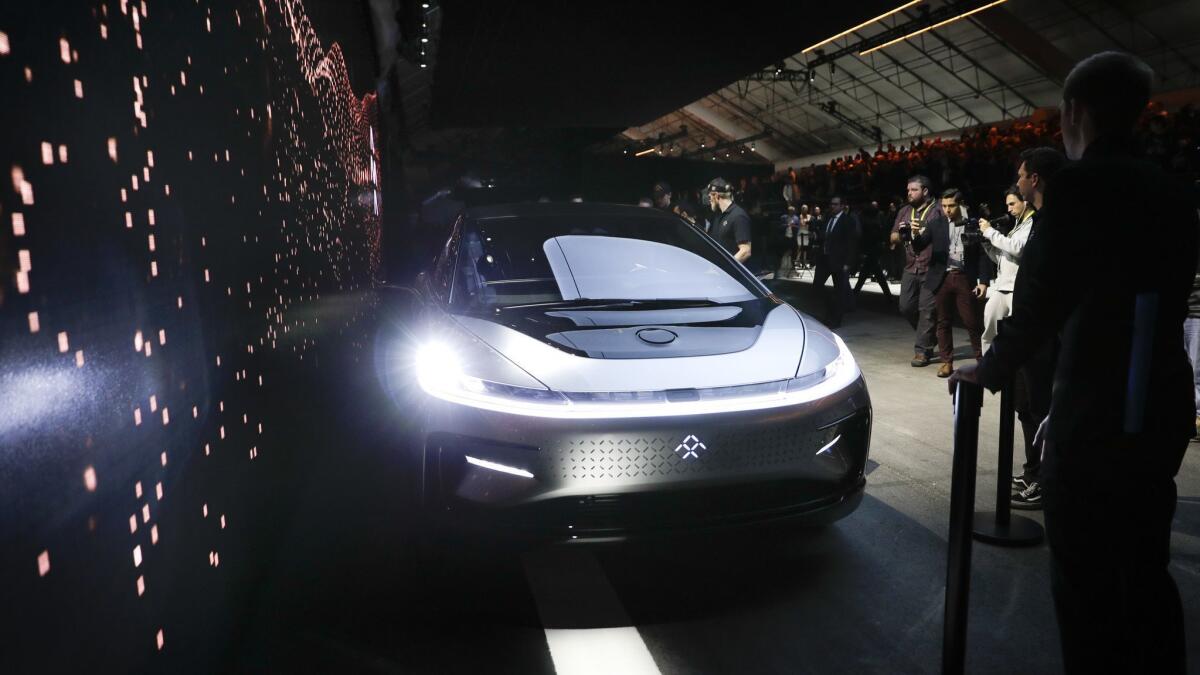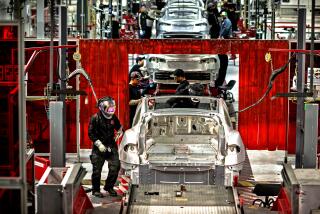Furloughs, executive departures hit struggling Faraday Future

Faraday Future, the luxury electric-car maker once billed as China’s answer to Tesla, is running out of juice.
A co-founder of Faraday has resigned after furloughs at the start-up, which is starved for cash as it continues to battle with its major investor.
The resignation of Nick Sampson, senior vice president of product strategy, and the planned furloughs follow by just one week layoffs and pay cuts at the Gardena company.
Also stepping down, the company said Tuesday, was Peter Savagian, senior vice president of global product and technology.
Faraday is developing an 1,000-horsepower sedan called the FF91 that it had planned to start selling next year for $180,000, but said it decided to put some workers on furlough because of “extraordinary financial hardship” as it seeks new financing.
“This was an extremely tough decision to make, and we recognize the emotional stress and financial strain this puts on people’s personal lives,” the company said in a statement.
Faraday is requiring that workers hired after May 1 go on furloughs until the end of the year, though the company acknowledged that the “actual length” depends on its financing. Employees who started before May 1 will continue with their regular schedule but at lower pay.
Faraday is short on funding after a $2-billion investment it received last year from a subsidiary of Chinese conglomerate Evergrande Group went sour.
Evergrande accused Faraday of wasting hundreds of millions of dollars in funding, but the automaker maintains the Shanghai company is trying to wrest control of Faraday and its intellectual property. Evergrande has denied the claims, according to Bloomberg.
The company was founded in 2014 with ambitions to compete in the U.S. electric vehicle market. But it ran into trouble after its founder, Chinese internet entrepreneur Jia Yueting, ran into severe financial difficulty in his home country, including a government-decreed freeze on assets.
Also known as YT Jia, he remains Faraday’s chief executive but is wanted for questioning by Chinese securities regulators.
Faraday had plans to build a massive factory outside Las Vegas that could produce 150,000 vehicles a year but downsized those ambitions and instead took over a former tire factory in Hanford, Calif., where it can produce 10,000 vehicles.
Last week, the company tweeted that it had won a round in arbitration against Evergrande in Hong Kong, and would be able to seek outside financing. It also said that the FF91 was continuing to undergo “software optimization and controls development testing” in Arizona.
It also announced it would start layoffs and that all employees would take 20% pay cuts. A company spokesman said Tuesday that the layoffs were completed last week and amounted to about 20% of its California workforce; it didn’t specify how many workers are affected.
With the departure of Sampson, a member of the company’s founding board, Faraday is losing an executive with electric-vehicle development experience. He headed vehicle and chassis engineering for the Tesla Model S sport sedan.
The Verge, which first reported his departure and the furloughs, said it obtained an email Sampson sent to employees, which stated the company is “effectively insolvent in both its financial and personnel assets” and will at best “limp along for the foreseeable future.”
The company said in its statement that it will pursue new funding from “investors globally,” takes its relationship with its suppliers “seriously” and hopes to “receive support and understanding” from its global partners.
A spokesman also said it plans to fully repay employees who have taken pay cuts or who have been furloughed once it receives new funding.
Times staff writers James F. Peltz and Russ Mitchell contributed to this report.
More to Read
Inside the business of entertainment
The Wide Shot brings you news, analysis and insights on everything from streaming wars to production — and what it all means for the future.
You may occasionally receive promotional content from the Los Angeles Times.











